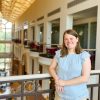Two weeks ago, I had the opportunity to attend the Association of Centers for the Study of Congress annual meeting in Washington, DC. This is somewhat of a catch-all group of congressional archivists as well as researchers of congressional collections. The conference was held in the National Archives building, which was an incredible opportunity in itself. I found this meeting to be a great place to meet (and commiserate with) other congressional archivists, and there were some great and informative panels! Here are my brief highlights:
The keynote speaker, Nancy Beck Young, gave a fascinating talk on her work studying John Nance Garner (Vice President under FDR and former Speaker of the House). He was a colorful character during a pivotal time in American history, but very little scholarship has been done on him because he burned his papers after leaving office. Young described her process of piecing together Garner’s life by finding him in other collections–she has researched over 100 collections on this topic!
Next was a panel from three archivists about special projects their institutions have undertaken with their congressional collections. The projects included documentary filmmaking, oral history projects, and developing AI and Python workflows to process electronic records in congressional collections. I especially enjoyed hearing about how oral histories can be great additions to congressional collections, and about the stories that congressional staffers can tell.
Another panel focused on the American Congress Digital Archives Portal, a project based at West Virginia University that aggregates congressional archives held by many partner institutions into one platform. I was glad to learn about this valuable resource for congressional research and explore opportunities for collaboration within congressional archives. I also enjoyed hearing about the issues that can arise with such collaborative projects (mostly involving metadata schemas and differing DAMS).
One of my favorite panels was with two former members of Congress, Martin Frost and Barbara Comstock, as well as the CEO of the Former Members of Congress organization Peter M. Weichlein. The panel focused on issues like election security, disinformation, polarization in Congress and among the voting public, loss of morale among congresspeople resulting in retirements, and many other topics. It was fascinating to hear candid thoughts from people who have firsthand knowledge of how Congress operates and the issues they face.
My conference concluded with a special tour given by one of the reference archivists at NARA. The group was unfortunately too large to go into the vault, but we were able to see some treasures. Some of my favorites were the original markup on the Bill of Rights (the first two amendments of this document did not make the cut) and Harriet Tubman’s pension application for her Civil War service. Lastly, to cap off my time in DC, I was able to visit Ford’s Theater and the National Gallery of Art. All in all, this was a wonderful conference that connected me to a community of congressional archivists. I know the knowledge I gained will help me as I finish up the Richard Burr papers over the next year.

4 Comments on ‘Kate at ACSC’
Kate, how cool that you were able to connect with others in your specific area of work! It sounds like you had a good experience and gained some useful info. Thanks for sharing — I found it interesting.
This is awesome, Kate. Thank you for sharing and adding links to resources. The American Congress Digital Archives Portal looks very interesting!
Interesting to know there’s an organization for Former Members of Congress! Makes sense that they may want to stay engaged. Glad you were able to go and learn about ways congressional collections can be accessed and studied!
Sounds like a fantastic experience, Kate! Glad you were able to attend.